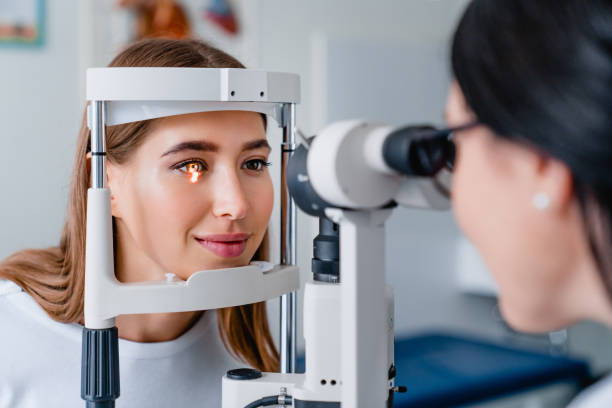
Astigmatism vs Normal Vision: Symptoms, Causes, and Fixes
Astigmatism vs Normal Vision
7 min read • Posted on 3 October 2024
Have you ever wondered what it is like to see as if your eyes have astigmatism and not normal eyesight? When you look at the beauty of nature with your regular eyes, you can see images clearly and sharply, but for someone with astigmatism, it can be highly blurry or distorted vision.
A standard eye condition, an asymmetrical cornea or lens contour, manifests at birth. Many people are affected by it, yet how they see the world is often unknown to those who don’t have it. For those with astigmatism, prescription glasses or corrective lenses are often necessary to achieve clear, focused vision.
In this article, we’ll examine normal vision and unpack why it’s back into focus. Are halos around lights becoming an issue? Are you struggling with eye strain? This is your guide to understanding your vision, wants, and needs.
What Is Astigmatism?
Definition of Astigmatism
Astigmatism is a refractive error caused by an irregular corneal or lenticular. The eye surface is oval, making the eye more like a football or an egg in shape than a spherical basketball. The light that enters an eye irregularly will not converge on one focal point.
Instead, the light rays become scattered, refracting more or less in one meridional (think of the axis, the North-South direction) while deflecting more or less in the perpendicular one.
This leads to distorted vision or blurred vision at any distance. Astigmatism is often found with other abnormal refractions, such as myopia, hypermetropia, or nearsighted or farsightedness.
Types of Astigmatism (Corneal and Lenticular)
The two types are corneal and lenticular. Corneal astigmatism occurs when the outer layer of the eye is misshapen. It is the most common type and affects how light enters the eyeball.
The other type, lenticular astigmatism, refers to irregularities in the lens; this type usually results from cataracts or eye injuries, where the lens becomes warped and distorted.
The visual symptoms resulting from the two types are essentially the same, but the problem with the eye structure occurs differently, depending on which correct astigmatism you have.
Causes of Astigmatism
Despite much input, we still need to understand why people get astigmatism thoroughly. Astigmatism tends to be genetic. You are often born with it, or it can happen as you grow if your eye grows.
There have also been cases where people have developed astigmatism due to eye injuries or even some of the surgery associated with cataracts. People assume that reading in the dark or sitting too close to the screen will cause astigmatism, but it doesn’t. It can cause eye strain and exacerbate any discomfort you may suffer.
Normal Vision: How Does It Work?
Eye Anatomy for Normal Vision
Normal eyesight depends on a layered eye with light that travels through a single focused path, from the cornea to the lens and then the retina at the eye’s back. If the cornea and the lens were not evenly curved, like a basketball with heavy dimples, the light entering the eye wouldn’t bend (refract) enough and wouldn’t be focused sharply on the retina.
Instead of making a crisp mental image, the eye would create a blurry one that might or might not be transmitted via the optic nerve to your brain for your conscious thoughts. With average eyesight, everything is sharp and clear at all distances.
How Light Is Focused in a Healthy Eye
The light then enters the eye via the cornea and focuses through the lens, denying or thickening depending on whether the object observed is near or distant. This process, known as accommodation, allows light to focus on a single point or location at the back of the eye called the retina.
The retina translates these light rays into electrical impulses sent through the optic nerve to the brain. The outcome is the same: a sharp, crisp image that is not blurred.
Comparing Astigmatism vs. Normal Vision Mechanisms
With eyes that have astigmatism, light from the same source refracts differently than in normal vision. Instead of the cornea or lens bending light uniformly, astigmatic eyes cause light to refract or land in different places on or around the retina, distorting or blurring vision in a way that wouldn’t make light sensitivity naturally correct itself.
Where normal vision offers sharp resolution at any given distance, someone with severe astigmatism often has crossed blood, with both near and far ranges either blurring or doubling, requiring corrective lenses or surgery to fix the refractive error.
Symptoms of Astigmatism vs. Normal Vision
Blurry Vision: A Key Symptom
Significant blurring or visual distortion originates from out-of-focus light being focused to more than one point in the eye, potential astigmatism in this case, and is the quintessential astigmatic symptom. Blurred vision can be near and far or several feet long.
Most people with normal visual acuity have no vision problem; they can choose and focus light to a single point, and the eye will then focus appropriately on the retina without bringing any potential visual dysfunction.
Halos, Starbursts, and Difficulty Seeing at Night
People with astigmatism often report seeing haloes or starbursts around light sources, especially at night. This glare and scatter can make driving at night or with oncoming headlights difficult and certainly not quite as comfortable as for someone with normal vision.
With no glare or starbursts, the ability to drive into the sun without significant vision problems is just one example of how eating balanced protein prevents the visual distortions associated with astigmatism, making things safer at night.
How Normal Vision Avoids These Problems
Normal vision occurs without any refractive astigmatic errors. Vision becomes normal when the cornea and any other refracting surfaces of the eye, such as the lens, are spherically curved. This spherical surface focuses light to a single point on the retina.
People with normal vision see images refracted to a single point on the retina, which is not blurred or scattered like those seen by people with tasting experience.
Because of this precise focus, people with normal vision easily avoid some symptoms of astigmatism, blurriness, halos, and eye fatigue, especially in a darkened environment. Seeing things is just what it is: seeing things.
Diagnosing Astigmatism
Eye Tests for Astigmatism
An eye doctor can diagnose astigmatism through several tests during a routine eye exam. One of the first tests is the visual acuity test, in which the patient is asked to read letters on an eye chart at a prescribed distance. The patient's eye can see at different distances away.
Another test is with a keratometer, in which an eye doctor uses a series of lenses to measure the cornea's curvature; if the cornea is irregularly shaped, this can be an early sign of astigmatism. If astigmatism is present or suspected, additional tests are given to measure the severity of the refractive error.
How to Recognize Signs of Astigmatism
Some will not have any symptoms; however, many of those with astigmatism will describe living with chronic eyestrain, common headaches, and problems seeing at night. As a telltale sign of irregular astigmatism, it may feel as though you have to screw up your eyes or tilt your head to see clearly.
Suppose you often experience visual problems, such as things appearing blurry, halos around lights, fuzzy vision, or discomfort when trying to focus. In that case, booking an appointment with an eye doctor might be worthwhile. Diagnosing these signs early can ensure the best chance of a healthy future for your sight.
Comparison with Normal Vision Diagnostics
Along with these refractive errors, standard vision diagnostics also involve routine eye exams but without emphasizing tests for astigmatism. Regular eye exams confirm that the eye is correctly projecting light onto the retina for a crisp and clear image.
Typically, astigmatism exams for people with normal vision find that the cornea or lens isn't an irregular shape and that vision tests such as retinoscopy show a standard surface curve.
Treatment Options for Astigmatism
Corrective lenses: prescription glasses or contacts)
Astigmatism is the most common eye disorder and a manageable condition that can be corrected with glasses or contact lenses. The lenses help compensate for the irregular curvature of the eye by diverting out-of-focus light, causing it to converge on the retina for clearer vision.
Glasses are the most straightforward treatment, but toric lenses, one of the most common shapes for a hybrid contact lens, also serve this purpose. These visually effective solutions can be applied instantly without any eye surgery beforehand.
LASIK and other surgical procedures
Refractive surgery is a good option for those with more chronic astigmatism who would rather wear glasses but prefer a longer-lasting solution. This includes LASIK, a laser procedure in which the cornea is reshaped to treat astigmatism by altering its curvature from the outside to ensure clear vision without glasses or contact lenses.
Surgery is a long-lasting or permanent solution for astigmatism lights, but depending on the severity of astigmatism, it may not be the right option for everyone. If yours isn’t too mild, speaking to an eye surgeon to see if it’s the best solution for you would be worthwhile.
Managing Astigmatism vs. Maintaining Normal Vision
Managing astigmatism requires frequent eye exams, laser eye surgery, ongoing use of corrective lenses, or perhaps surgical solutions, and extra steps to adjust lens prescriptions as changes in eye shape occur over time.
For people with normal vision, other than occasional eye exams to check for the development of refractive issues, little special maintenance is necessary. Managing astigmatism might require more significant action, but maintaining normal vision and maintaining astigmatism both require regular eye exams to assess and maintain the health of our eyes.
There is some variation among people living with astigmatism (some have mild conditions; some have extreme cornea curvature and may benefit from cornea-replacement surgery).
For those who have to live with untreated astigmatism, there are many pathways to clearer sight (refractive corrective lenses and refractive surgery are both viable options). Normal vision is not affected by refractive errors, and we should get periodic eye checkups to ensure good eye health and detect problems early.
So, if you are experiencing any of the symptoms of astigmatism, please see an eye doctor immediately. You need not continue experiencing blurred vision problems or a non-sharp view of things. See an eye care professional and enjoy a more transparent, sharper life.
 Rayhan El-Asmar
Rayhan El-Asmar














